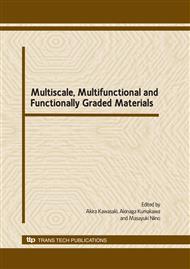p.477
p.483
p.489
p.495
p.501
p.507
p.513
p.519
p.525
Alloy Compositional Gradation in Surface Layer and Oxidation Resistance on Chemical Synthesized FeCo Nanoparticles
Abstract:
X-ray photoelectron spectroscopy (XPS) has been used for analyzing the surface composition of polyol process-derived Fe30Co70, Fe50Co50, and Fe70Co30 alloy nanoparticles with diameters 50, 100 and 150 nm, respectively. These Fe-Co alloy particles have high oxidation resistance in the atmospheric environment even though their particle size is so small. The XPS results revealed that the concentration of iron at the surface of the as-synthesized Fe-Co alloy nanoparticles was lower than that in bulk and increased with increasing bulk cobalt composition, although the surface of nanoparticles was covered with native oxide layer formed during their exposure to atmosphere. This low concentration of iron and very thin oxide layer at the surface are considered to protect the particle from oxidation. The concentration of iron at the surface of Fe70Co30 nanoparticles increased when they were annealed at 573 K in N2 and H2 atmosphere. The results indicate that nonuniformity of the chemical composition between particle surface and core occurs during the formation of the same in polyol, and atomic diffusion at the surface of particle can occur even at relatively low temperature. The above is considered to arise from the difference in the chemical characteristics of iron and cobalt during co-precipitation in the polyol.
Info:
Periodical:
Pages:
507-512
Citation:
Online since:
October 2009
Authors:
Price:
Сopyright:
© 2010 Trans Tech Publications Ltd. All Rights Reserved
Share:
Citation:


